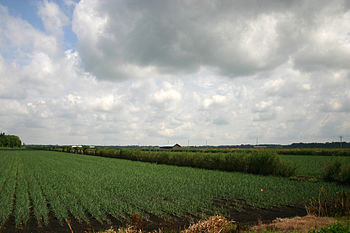- Muck (soil)
-
Muck is a soil made up primarily of humus from drained swampland. It is known as black soil in The Fens of eastern England, where it was originally mainly fen and bog. It is used there, as in the United States, for growing specialty crops such as onions, carrots, celery, and potatoes. Holland Marsh, north of Toronto, Ontario is the site of the Muck Crops Research Station, a part of the University of Guelph.
Muck farming on drained bogs is an important part of agriculture in New York, Ohio, Illinois, Indiana, Michigan, Wisconsin, and Florida, where mostly vegetables are grown. American "muckers" often have roots from the Netherlands or Eastern Europe, where their ancestors practiced a similar type of farming. The soils are deep, dark colored, and friable, often underlain by marl or marly clay. The muckland of Torrey Farms of Elba, New York, which covers the counties of Orleans, Niagara, and Genesee, is thought to be the largest continuous section of muckland in the world.[1]
Muck farming is controversial, because the drainage of wetlands destroys wildlife habitat and produces other environmental problems. It is unlikely that any more will be created in the US, because of environmental regulations. It is prone to problems, such as the fact that it is very light and usually windbreaks must be provided to keep it from blowing away when dry. It also can catch fire and burn underground for months. Oxidation also removes a portion of the soil each year, so it becomes progressively shallower. Some muck land has been reclaimed for wildlife preserves.
See also
- Peat
- Torrey Farms
mucking - the act of removing river sludge (muck)from an object or structure (ie, flooding, hurricane, natural disasters)
References
External links
- Barbagallo, Tricia (June 1, 2005). "Black Beach: The Mucklands of Canastota, New York" (PDF). http://www.archives.nysed.gov/apt/magazine/MagSummer05FeatureArticle_000.pdf. Retrieved 2008-06-04.
- The Horicon National Wildlife Refuge was established on muck land returned as much as possible to the original state. http://midwest.fws.gov/horicon/Hisettlepg3.html
- An example of a typical muck farming operation: http://www.vegetablegrowersnews.com/pages/2003/issue_03_08/03_08_zellers_soil.html

This soil science-related article is a stub. You can help Wikipedia by expanding it.

